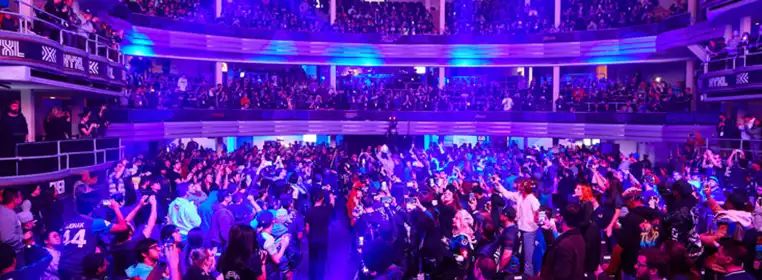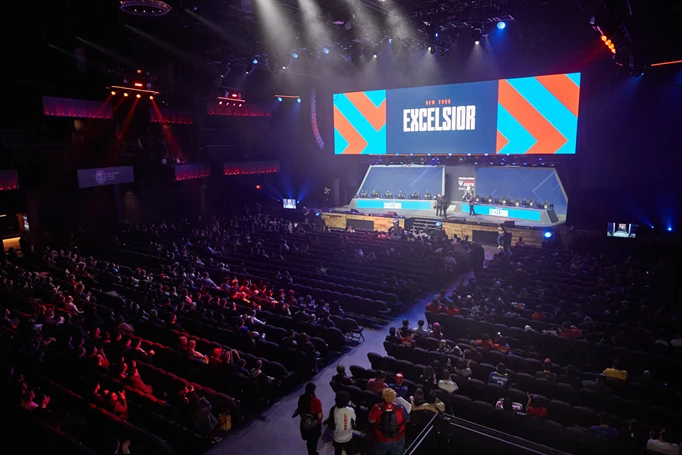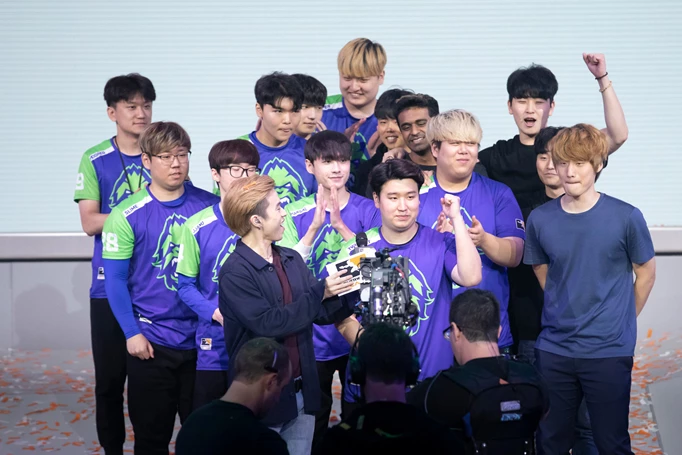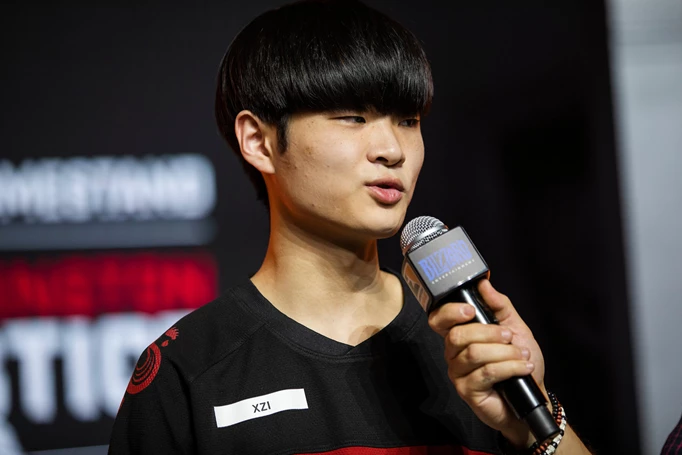Ups And Downs But Floating - The Guiding Stories Of The Regular Season In Review

Potluck, patchwork, and lemonade stand - Overwatch League season 3 was a season of makeshift everything from which valuable lessons arose. A global pandemic, waning viewership numbers, and exhausted professionals were tough challenges that allowed for not just course-correcting but daring solutions from which the league walked away stronger. In a time during which we were locked in at home, we got to see comebacks, turnarounds, and young people reach for their dreams. We had to say goodbye to legends, and moved closer to the ones we have left.
We started out with at least the initial fulfilment of the league’s cornerstone feature, homestands. In total, we got to see the theory of a localised esports league put into practice in six different events, with the Justice getting to host two of their initially planned five homestands. Unfortunately due to COVID-19, we didn’t get to enjoy a single Asian event.
In the season opener, the Toronto Defiant beat the Paris Eternal in New York, a result that now seems very far away. Between then and the spicy season closer between the Gladiators and the Valiant, a lot has happened. These are the ups and downs of the 2020 Overwatch League regular season.
In the clouds but no C9
As the world closed down, the Overwatch League had to move into the cloud. The task seemed insurmountable, and some voices were unsure if it could be done, going as far as to question whether it was sensible to continue playing out the season. At the same time, there was a huge opportunity for esports, being able to broadcast competition while keeping social distance, placing the playing field in a virtual arena.
While the competition was digital, many important aspects were not, and the physical shackles were still severe. Where would production take place? How could we assure the safety of all professionals involved? How does travel, visa, and quarantine work? Can we even afford to think about competitive integrity? Can we create an engaging product with the hardware everyone else has at their disposal?
With waning viewership numbers on YouTube, and without drops to give the metrics a helping hand, the outlook was bleak for a while. The vision of what the Overwatch League was meant to be had to change, and the situation gave us all the justification to experiment. The league began to explore, giving rope in many creative directions. Match chats were enabled and hilarity ensued. Trash talk was encouraged and blood feuds were made. Tools were given and creators created. The entertainment factor of the Overwatch League rose accordingly.

 Click to enlarge
Click to enlargeThe regional split
Regions were split up between Asia and North America, with New York, London Spitfire, and for a time, the Titans leaving their city region to equalise the number of teams playing in each region.
With the final split of seven teams in Asia and 13 teams in North America, the number of teams was uneven, and the lack of interregional play raised question marks about the quality of each region. Opinions swayed back and forth, often in tandem with the hero pools, though the density of good teams in APAC was generally perceived to be higher.
Due to necessity, the Overwatch League and its audience got to witness what regional separation may look and feel like, which experts think could turn out to be an important lesson moving forward into the future.
Hero pools were fluid
Before the season, Overwatch League introduced the hero pools feature which throughout the season would go through many different iterations. Experiments with the selection methods of those bans ranged from crazed casters, to cats, to ranked, and Overwatch League play rate. Initially a spectacle, the hype around each week’s bans died down as the feature moved to a model in which an unknown algorithm spat out a list of heroes.

 Click to enlarge
Click to enlargeWith no hero reaching a play rate above 50% during the regular season, the problem of meta monotony that hero pools had set out to do was arguably achieved, allowing for a wide range of archetypes to become the meta composition of the week.
Top teams like the Shanghai Dragons, San Francisco Shock, and Philadelphia Fusion remained unwaveringly top tier throughout the vast majority of weeks, showing that flexibility through coaching, talent, and a wide roster could be achieved. Teams at tiers below the top three teams saw more impact on their performance based on the bans, for some, especially in the mid-season, revealing a wide delta of performances, though we can’t say for sure if hero pools were the determining factor. Seoul Dynasty could go from winning against Shanghai Dragons one week, to losing to the Hunters in the next - perhaps only revealing an inherent quality of inconsistency in the team. The Paris Eternal and the Guangzhou Charge enjoyed their time on the throne of their respective region, winning one tournament each.
An issue that arose with hero pools was that it put pressure on teams each week to find the optimal strategy, with many coaches and players working heavy hours to grind into confidence on each week’s meta iteration. Once decoupled from the ranked play queue, the league could change the length of hero pools, with the last iteration settled on a two-week cycle which saw some compositional stability established into play, and teams reportedly feeling a little more relief on their workload.
The jury on hero pools is still out, with the general vocal reception of fans being that they enjoyed the meta diversity. Additional investigation on viewership engagement, workability of the feature, and amendments or even necessity of hero pools for next season will likely be discussed during the off-season. While most of the regular season were held under hero pools, the feature was not represented in tournaments, and won’t be part of the playoff format, showing a qualification mode that’s unaligned with knockout stages.
Tournaments to feel something
After the cut of stage playoffs that the league played out in season 1 and season 2, the only pre-playoff knockout staged tournament that was initially planned was the mid-season event. Likely due to the new situation, and new opportunities due to a lack of travel burden, the league pivoted to a model that incorporated tournaments to a degree, like the model its sister league, the Call of Duty League, ran. Starting with the May Melee, fans got to enjoy relatively high stakes Overwatch which breathed fresh air into the competition. With token drops hitting at the same time as tournaments, the viewership data is a little muddied, but the overall reception of the event in the vocal parts of the community was overwhelmingly positive.
The Shock once again got to demonstrate their dominance in all three tournaments, though their streak was broken by the Paris Eternal during the Summer Showdown. In the East, the Dragons became the Shock of Asia, only losing one of the tournaments to the Charge.
Tournaments came with attached stakes of prize pool and bonus wins, the latter ending up not heavily influencing the regular-season rankings outside the crucial case of the Valiant, getting to pull ahead of the Gladiators for the important fifth place in the North American region.

 Click to enlarge
Click to enlargeTitans fall apart
One of the most tragic events which occurred in the Overwatch League during the regular season resulted in the break up of the legendary roster formerly known as RunAway and the Vancouver Titans of season 2. With a long legacy reaching back to the early stages of competitive Overwatch, the team broke apart over a dispute with the Titans organisation. The members were scattered in the winds, most of them landing on various different teams. Min-soo "SeoMinSoo" Seo, Chan-hyung "Fissure" Baek and Jehong "ryujehong" Ryu have yet to find a new Overwatch League team. Main tank Sang-beom "Bumper" Park, who had departed from the Titans late into season 2 has seemingly vanished.
With the Titans untimely demise, a part of Overwatch history came to an end. Sometimes acting as a contrast to champions in the many instances, they came second in their history, other times as the main actors themselves when they won Contenders or the stage 1 finals of Overwatch League season 2. From a family of underdogs, to forever second places, to eventual champions and likeable villains, the positions this team inhabited shaped the history of competitive Overwatch significantly.
Saying goodbye
On top of star players and personalities like Fissure, Bumper and ryujehong not finding their way back into Overwatch League, season 3 was also the season of painful departures, culminating in the retirement of Jay “sinatraa” Won, the season 2 most valuable player.
In front of our eyes, a young man had transformed from a toxic ladder personality to a leader for his team, staying relatively contained in his antics for the latter parts of his career in Overwatch. Seeing the opportunity of the new emerging esport VALORANT and having fallen out of love with the game, citing reasons like role lock and hero pools, sinatraa retired from competitive Overwatch at the age of 20. Others players like Andrej "babybay" Francisty, Corey "Corey" Nigra, Damien "HyP" Souville, Shane "Rawkus" Flaherty, and more would go down the same path, leaving large gaps in the fabric of the scene and holes the scene has yet to fully recover from.
The excitingly unpredictable few
Arguably more strongly than the years before, it was a season of teams defying expectations, both positively and negatively. Teams like the Atlanta Reign and the Washington Justice performed significantly worse than expert opinion predicted in the pre-season, with the Justice remaining one of the worst teams for a second year in a row, despite a mid-season pivot to a full Korean roster. The Justice may in some sense resemble the Mayhem of season 2, having undergone similar changes at the end of season 2 which built the foundation for their first season. For the Reign, their season didn’t turn out to be a disaster but based on their strong finish in season 2 and their distinctly upgraded roster, many experts predicted them to do significantly better than the 12th place (seventh in North America) they ended up with.
Even more unexpected than these fall offs were the dark horses of season 3, namely the Paris Eternal, Florida Mayhem, and the Los Angeles Valiant. Paris started into the season in rocky fashion though quickly became able to bring the fight to the Fusion in the first week of hero pools, beating the Fusion in a very close 3-2.
While most experts saw the parts of Element Mystic in Han-been "Hanbin" Choi, Ki-hyo "Xzi" Jung and Yeong-han "SP9RK1E" Kim succeed to some degree in the Overwatch League, there were questions about timing of the eligibility of SP9RK1E. Many experts also didn’t have Xzi playing to the level he consistently did when he was able to play, being out of active play for a large chunk of the season due to an injury. The most surprising development came with the emergence of Benjamin "BenBest" Dieulafait as a top tier tank, a quality most didn’t see in him based on his season 2 play. Before SP9RK1E, Nicolas "NiCOgdh" Moret did an admirable job on the flex DPS position, performing outstandingly especially on Doomfist. Brice "FDGod" Monsçavoir, a name that only was spoken about late into the pre-season, became a standout performer on the main support role.

 Click to enlarge
Click to enlargeThe Mayhem project of finally becoming a force to be reckoned with after having been a bottom team for two season in the Overwatch League came to fruition, with an exciting injection of RunAway players and coaches and players like Beom-jun "Gargoyle" Lee and Sang-bum "BQB" Lee coming into their own. Without Jung-woo "Sayaplayer" Ha, the Mayhem landed a top five spot in North America, an unthinkable feat when viewed from the pre-season. Pan-seung "Fate" Koo arguably found back to old glory of season 1, cementing himself as one of the best tanks in the league.
The budget crew of the Los Angeles Valiant, a team with some of the least resources available in the league, managed to snag a top five spot in North America too. Made up of a lot of unappreciated talent, the team had to fight an uphill battle against expectations of them becoming one of the worst teams in Overwatch League. Singings like Kai "KSP" Collins brought experts around at the last moment, but nobody predicted them to be contesting for the top spots. Despite having to drop two coaches in the mid-season and only getting to pick up Max "Unter" Unterwurzacher late, the coaching staff managed to achieve the impossible while also having to coach the Immortals VALORANT roster at the same time. Nobody has ever achieved as much less.
Lastly, we saw the Shanghai Dragons complete their turnaround, hitting the Uno reverse card on their season record and becoming one of the most dominant teams in the world only two years after having been the fabled 0-40 team, arguably one of the worst teams in modern sports. Along with them re-emerged Eui-Seok "Fearless" Lee, becoming one of the greatest comeback stories the Overwatch competitive scene has ever seen.
It was a season of hardship, stress and force majeure but also one that showed the true spirit of the competitors and the team working this league. Overwatch esports prevailed. May it never die.
Images via Blizzard Entertainment
